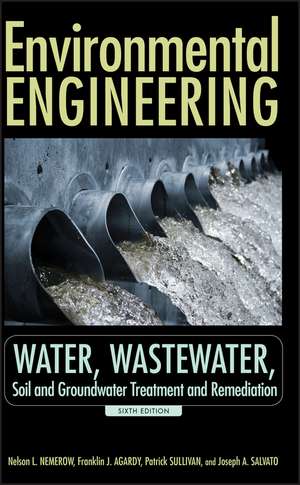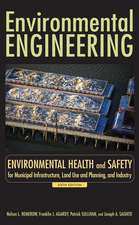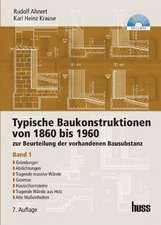Environmental Engineering 6e – Water, Wastewater Soil and Groundwater Treatment and Remediation
Autor NL Nemerowen Limba Engleză Hardback – 5 feb 2009
This volume, Environmental Engineering: Water, Wastewater, Soil and Groundwater Treatment and Remediation, Sixth Edition, covers:
- Water treatment
- Water supply
- Wastewater treatment
Preț: 910.88 lei
Preț vechi: 1000.97 lei
-9% Nou
Puncte Express: 1366
Preț estimativ în valută:
174.29€ • 181.99$ • 143.93£
174.29€ • 181.99$ • 143.93£
Carte tipărită la comandă
Livrare economică 15-29 aprilie
Preluare comenzi: 021 569.72.76
Specificații
ISBN-13: 9780470083031
ISBN-10: 0470083034
Pagini: 400
Dimensiuni: 156 x 235 x 21 mm
Greutate: 0.66 kg
Ediția:6th Edition
Editura: Wiley
Locul publicării:Hoboken, United States
ISBN-10: 0470083034
Pagini: 400
Dimensiuni: 156 x 235 x 21 mm
Greutate: 0.66 kg
Ediția:6th Edition
Editura: Wiley
Locul publicării:Hoboken, United States
Public țintă
Practicing environmental and civil engineers; Government regulatory personnel; environmental consultants; environmental scientists; undergraduate and graduate–levelDescriere
Environmental Engineering
First published in 1958, Salvato′s Environmental Engineering has long been the definitive reference for generations of sanitation and environmental engineers. Approaching its fiftieth year of continual publication in a rapidly changing field, the Sixth Edition has been fully reworked and reorganized into three separate, succinct volumes to adapt to a more complex and scientifically demanding field with dozens of specializations.
Updated and reviewed by leading experts in the field, this revised edition offers new process and plant design examples and added coverage of such subjects as urban and rural systems. Stressing the practicality and appropriateness of treatment, the Sixth Edition provides realistic solutions for the practicing public health official, water treatment engineer, plant operator, and others in the domestic and industrial waste treatment professions.
This volume, Environmental Engineering: Water, Wastewater, Soil and Groundwater Treatment and Remediation, covers:
First published in 1958, Salvato′s Environmental Engineering has long been the definitive reference for generations of sanitation and environmental engineers. Approaching its fiftieth year of continual publication in a rapidly changing field, the Sixth Edition has been fully reworked and reorganized into three separate, succinct volumes to adapt to a more complex and scientifically demanding field with dozens of specializations.
Updated and reviewed by leading experts in the field, this revised edition offers new process and plant design examples and added coverage of such subjects as urban and rural systems. Stressing the practicality and appropriateness of treatment, the Sixth Edition provides realistic solutions for the practicing public health official, water treatment engineer, plant operator, and others in the domestic and industrial waste treatment professions.
This volume, Environmental Engineering: Water, Wastewater, Soil and Groundwater Treatment and Remediation, covers:
- Water treatment
- Water supply
- Wastewater treatment
- Environmental Engineering, Sixth Edition: Prevention and Response to Water–, Food–, Soil–, and Airborne Disease and Illness978–0–470–08304–8
- Environmental Engineering, Sixth Edition: Environmental Health and Safety for Municipal Infrastructure, Land Use and Planning, and Industry978–0–470–08305–5
Textul de pe ultima copertă
Environmental Engineering
First published in 1958, Salvato′s Environmental Engineering has long been the definitive reference for generations of sanitation and environmental engineers. Approaching its fiftieth year of continual publication in a rapidly changing field, the Sixth Edition has been fully reworked and reorganized into three separate, succinct volumes to adapt to a more complex and scientifically demanding field with dozens of specializations.
Updated and reviewed by leading experts in the field, this revised edition offers new process and plant design examples and added coverage of such subjects as urban and rural systems. Stressing the practicality and appropriateness of treatment, the Sixth Edition provides realistic solutions for the practicing public health official, water treatment engineer, plant operator, and others in the domestic and industrial waste treatment professions.
This volume, Environmental Engineering: Water, Wastewater, Soil and Groundwater Treatment and Remediation, covers:
First published in 1958, Salvato′s Environmental Engineering has long been the definitive reference for generations of sanitation and environmental engineers. Approaching its fiftieth year of continual publication in a rapidly changing field, the Sixth Edition has been fully reworked and reorganized into three separate, succinct volumes to adapt to a more complex and scientifically demanding field with dozens of specializations.
Updated and reviewed by leading experts in the field, this revised edition offers new process and plant design examples and added coverage of such subjects as urban and rural systems. Stressing the practicality and appropriateness of treatment, the Sixth Edition provides realistic solutions for the practicing public health official, water treatment engineer, plant operator, and others in the domestic and industrial waste treatment professions.
This volume, Environmental Engineering: Water, Wastewater, Soil and Groundwater Treatment and Remediation, covers:
- Water treatment
- Water supply
- Wastewater treatment
- Environmental Engineering, Sixth Edition: Prevention and Response to Water–, Food–, Soil–, and Airborne Disease and Illness978–0–470–08304–8
- Environmental Engineering, Sixth Edition: Environmental Health and Safety for Municipal Infrastructure, Land Use and Planning, and Industry978–0–470–08305–5
Cuprins
PREFACE. CONTRIBUTORS.
CHAPTER 1 WATER SUPPLY (T. David Chinn).
Introduction.
Groundwater Pollution Hazard.
Travel of Pollution through the Ground.
Disease Transmission.
Water Quantity and Quality.
Water Cycle and Geology.
Groundwater Flow.
Groundwater Classification.
Water Quality.
Sampling and Quality of Laboratory Data.
Sanitary Survey and Water Sampling.
Sampling Frequency.
Water Analyses.
Heterotrophic Plate Count The Standard Plate Count.
Bacterial Examinations.
Biological Monitoring.
Virus Examination.
Protozoa and Helminths Examination.
Specific Pathogenic Organisms.
Physical Examinations.
Microscopic Examination.
Chemical Examinations.
Drinking Water Additives.
Water Quantity.
Water Conservation.
Water Reuse.
Source and Protection of Water Supply.
General.
Groundwater.
Dug Well.
Bored Well.
Driven and Jetted Well.
Drilled Well.
Well Development.
Grouting.
Well Contamination Cause and Removal.
Spring.
Infiltration Gallery.
Cistern.
Domestic Well–Water Supplies Special Problems.
Household Treatment Units (Point–of–Use and Point–of–Entry).
Desalination.
References.
Bibliography.
CHAPTER 2 WATER TREATMENT (T. David Chinn).
Treatment of Water Design and Operation Control.
Introduction.
Surface Water.
Treatment Required.
Disinfection.
Gas Chlorinator
Testing for Residual Chlorine.
Chlorine Treatment for Operation and Microbiological Control.
Distribution System Contamination.
Plain Sedimentation.
Microstraining.
Coagulation, Flocculation, and Settling.
Filtration.
Slow Sand Filter.
Rapid Sand (Granular Media) Filter.
Direct Filtration.
Pressure Sand Filter.
Diatomaceous Earth Filter.
Package Water Treatment Plant.
Water Treatment Plant Wastewater and Sludge.
Causes of Tastes and Odors.
Control of Microorganisms.
Zebra Mussel and Its Control.
Aquatic Weed Control.
Other Causes of Tastes and Odors.
Methods to Remove or Reduce Objectionable Tastes and Odors.
Iron and Manganese Occurrence and Removal.
Corrosion Cause and Control.
Removal of Inorganic Chemicals.
Prevention and Removal of Organic Chemicals.
Water System Design Principles.
Water Quantity.
Design Period.
Watershed Runoff and Reservoir Design.
Intakes and Screens.
Pumping.
Distribution Storage Requirements.
Peak Demand Estimates.
Distribution System Design Standards.
Small Distribution Systems.
Fire Protection.
Cross–Connection Control.
Hydropneumatic Systems.
Pumps.
Displacement Pump.
Centrifugal Pump, Also Submersible and Turbine.
Jet Pump.
Air–Lift Pump.
Hydraulic Ram.
Pump and Well Protection.
Pump Power and Drive.
Automatic Pump Control.
Water Hammer.
Rural Water Conditions in the United States.
Design of a Household Water System.
Examples.
Design of Small Water Systems.
Design of a Camp Water System.
Water System Cost Estimates.
Cleaning and Disinfection.
Wells and Springs.
Pipelines.
Storage Reservoirs and Tanks.
Emergency Water Supply and Treatment.
Boiling.
Chlorination.
Iodine.
Filtration in an Emergency.
Bottled, Packaged, and Bulk Water.
References.
Bibliography.
CHAPTER 3 WASTEWATER TREATMENT AND DISPOSAL (John R. Kiefer).
Disease Hazard.
Criteria for Proper Wastewater Disposal.
Definitions.
Small Wastewater Disposal Systems.
Wastewater Characteristics.
Soil Characteristics.
Soil Suitability.
Pollutant Travel from Septic Systems.
Soil Percolation Test.
Sewage Flow Estimates.
Septic Tank.
Care of Septic Tank and Subsurface Absorption Systems.
Subsurface Soil Absorption Systems.
Absorption Field System.
Leaching Pit.
Cesspool.
Dry Well.
Small Wastewater Disposal Systems for Unsuitable Soils or Sites.
General.
Modified Septic Tank Soil Absorption System.
Example.
Capillary Seepage Trench.
Raised Bed Absorption–Evapotranspiration System.
Septic Tank Sand Filter System.
Aerobic Sewage Treatment Unit.
Septic Tank Mound System.
Example 1.
Electric Osmosis System.
Septic Tank Evapotranspiration System.
Example 2.
Water Conservation.
Sewage Works Design Small Treatment Plants.
Disinfection.
Physical–Chemical Treatment.
Sedimentation.
Coagulation/Flocculation.
Filtration.
Activated Carbon Adsorption.
Biological Treatment.
Wastewater Reuse.
Wastewater Aerosol Hazard.
Wastewater Disposal by Land Treatment.
Advanced Wastewater Treatment.
Typical Designs for Small Treatment Plants.
Standard–Rate Trickling Filter Plant with Imhoff Tank.
High–Rate Trickling Filter Plant with Imhoff Tank.
Intermittent Sand Filter Plant with Imhoff Tank or Septic Tank.
Design of Large Treatment Plants.
Biosolids Treatment and Disposal.
Cost of Sewage Treatment.
Industrial Wastes.
Hazardous and Toxic Liquid Wastes.
Pretreatment.
References.
Bibliography.
INDEX.
CHAPTER 1 WATER SUPPLY (T. David Chinn).
Introduction.
Groundwater Pollution Hazard.
Travel of Pollution through the Ground.
Disease Transmission.
Water Quantity and Quality.
Water Cycle and Geology.
Groundwater Flow.
Groundwater Classification.
Water Quality.
Sampling and Quality of Laboratory Data.
Sanitary Survey and Water Sampling.
Sampling Frequency.
Water Analyses.
Heterotrophic Plate Count The Standard Plate Count.
Bacterial Examinations.
Biological Monitoring.
Virus Examination.
Protozoa and Helminths Examination.
Specific Pathogenic Organisms.
Physical Examinations.
Microscopic Examination.
Chemical Examinations.
Drinking Water Additives.
Water Quantity.
Water Conservation.
Water Reuse.
Source and Protection of Water Supply.
General.
Groundwater.
Dug Well.
Bored Well.
Driven and Jetted Well.
Drilled Well.
Well Development.
Grouting.
Well Contamination Cause and Removal.
Spring.
Infiltration Gallery.
Cistern.
Domestic Well–Water Supplies Special Problems.
Household Treatment Units (Point–of–Use and Point–of–Entry).
Desalination.
References.
Bibliography.
CHAPTER 2 WATER TREATMENT (T. David Chinn).
Treatment of Water Design and Operation Control.
Introduction.
Surface Water.
Treatment Required.
Disinfection.
Gas Chlorinator
Testing for Residual Chlorine.
Chlorine Treatment for Operation and Microbiological Control.
Distribution System Contamination.
Plain Sedimentation.
Microstraining.
Coagulation, Flocculation, and Settling.
Filtration.
Slow Sand Filter.
Rapid Sand (Granular Media) Filter.
Direct Filtration.
Pressure Sand Filter.
Diatomaceous Earth Filter.
Package Water Treatment Plant.
Water Treatment Plant Wastewater and Sludge.
Causes of Tastes and Odors.
Control of Microorganisms.
Zebra Mussel and Its Control.
Aquatic Weed Control.
Other Causes of Tastes and Odors.
Methods to Remove or Reduce Objectionable Tastes and Odors.
Iron and Manganese Occurrence and Removal.
Corrosion Cause and Control.
Removal of Inorganic Chemicals.
Prevention and Removal of Organic Chemicals.
Water System Design Principles.
Water Quantity.
Design Period.
Watershed Runoff and Reservoir Design.
Intakes and Screens.
Pumping.
Distribution Storage Requirements.
Peak Demand Estimates.
Distribution System Design Standards.
Small Distribution Systems.
Fire Protection.
Cross–Connection Control.
Hydropneumatic Systems.
Pumps.
Displacement Pump.
Centrifugal Pump, Also Submersible and Turbine.
Jet Pump.
Air–Lift Pump.
Hydraulic Ram.
Pump and Well Protection.
Pump Power and Drive.
Automatic Pump Control.
Water Hammer.
Rural Water Conditions in the United States.
Design of a Household Water System.
Examples.
Design of Small Water Systems.
Design of a Camp Water System.
Water System Cost Estimates.
Cleaning and Disinfection.
Wells and Springs.
Pipelines.
Storage Reservoirs and Tanks.
Emergency Water Supply and Treatment.
Boiling.
Chlorination.
Iodine.
Filtration in an Emergency.
Bottled, Packaged, and Bulk Water.
References.
Bibliography.
CHAPTER 3 WASTEWATER TREATMENT AND DISPOSAL (John R. Kiefer).
Disease Hazard.
Criteria for Proper Wastewater Disposal.
Definitions.
Small Wastewater Disposal Systems.
Wastewater Characteristics.
Soil Characteristics.
Soil Suitability.
Pollutant Travel from Septic Systems.
Soil Percolation Test.
Sewage Flow Estimates.
Septic Tank.
Care of Septic Tank and Subsurface Absorption Systems.
Subsurface Soil Absorption Systems.
Absorption Field System.
Leaching Pit.
Cesspool.
Dry Well.
Small Wastewater Disposal Systems for Unsuitable Soils or Sites.
General.
Modified Septic Tank Soil Absorption System.
Example.
Capillary Seepage Trench.
Raised Bed Absorption–Evapotranspiration System.
Septic Tank Sand Filter System.
Aerobic Sewage Treatment Unit.
Septic Tank Mound System.
Example 1.
Electric Osmosis System.
Septic Tank Evapotranspiration System.
Example 2.
Water Conservation.
Sewage Works Design Small Treatment Plants.
Disinfection.
Physical–Chemical Treatment.
Sedimentation.
Coagulation/Flocculation.
Filtration.
Activated Carbon Adsorption.
Biological Treatment.
Wastewater Reuse.
Wastewater Aerosol Hazard.
Wastewater Disposal by Land Treatment.
Advanced Wastewater Treatment.
Typical Designs for Small Treatment Plants.
Standard–Rate Trickling Filter Plant with Imhoff Tank.
High–Rate Trickling Filter Plant with Imhoff Tank.
Intermittent Sand Filter Plant with Imhoff Tank or Septic Tank.
Design of Large Treatment Plants.
Biosolids Treatment and Disposal.
Cost of Sewage Treatment.
Industrial Wastes.
Hazardous and Toxic Liquid Wastes.
Pretreatment.
References.
Bibliography.
INDEX.
Notă biografică
The Late Nelson L. Nemerow, PhD, was an environmental engineering and water consultant. He was a professor at the University of Miami and the former head of Environmental Engineering at Syracuse University. He published over 210 technical papers and twenty–three textbooks.
Franklin J. Agardy, PhD, is founding partner of Forensic Management Associates. As a civil engineering professor, he developed San Jose State′s graduate program in sanitary engineering. He has written, coauthored, or coedited seven textbooks.
Patrick Sullivan, PhD, is founding partner of Forensic Management Associates. Prior to his forensics career, he was a senior environmental analyst at the Jet Propulsion Laboratory at the California Institute of Technology. He has written, coauthored, or coedited five textbooks.
The Late Joseph A. Salvato served as a sanitary and public health engineer consultant and assistant commissioner in the Division of Sanitary Engineering for the New York State Department of Health. He was also a Fellow of the ASCE and the APHA and adjunct associate professor at Rensselaer Polytechnic Institute.
Franklin J. Agardy, PhD, is founding partner of Forensic Management Associates. As a civil engineering professor, he developed San Jose State′s graduate program in sanitary engineering. He has written, coauthored, or coedited seven textbooks.
Patrick Sullivan, PhD, is founding partner of Forensic Management Associates. Prior to his forensics career, he was a senior environmental analyst at the Jet Propulsion Laboratory at the California Institute of Technology. He has written, coauthored, or coedited five textbooks.
The Late Joseph A. Salvato served as a sanitary and public health engineer consultant and assistant commissioner in the Division of Sanitary Engineering for the New York State Department of Health. He was also a Fellow of the ASCE and the APHA and adjunct associate professor at Rensselaer Polytechnic Institute.










